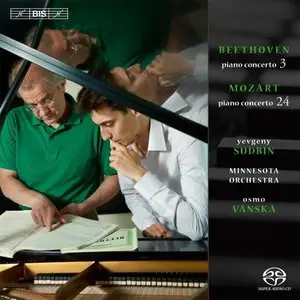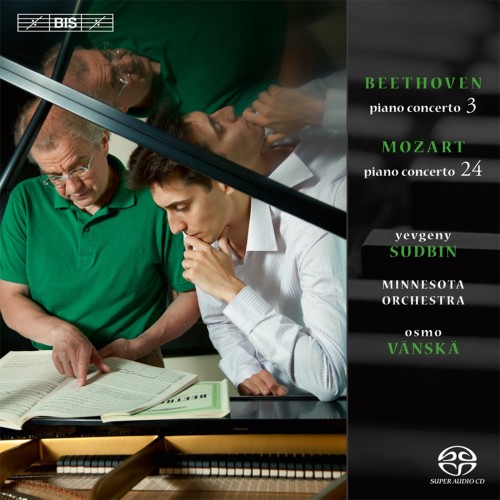Sudbin, Vanska - Beethoven: Piano Concerto No 3; Mozart: Piano Concerto No 24 (2014)
EAC Rip | Flac (Image + cue + log) | 1 CD | Full Scans | 252 MB
Genre: Classical | Label: Bis | Catalog Number: 1978
EAC Rip | Flac (Image + cue + log) | 1 CD | Full Scans | 252 MB
Genre: Classical | Label: Bis | Catalog Number: 1978
In 2010 Yevgeny Sudbin released the first instalment in a cycle of Beethoven's piano concertos. Featuring the Fourth and the Fifth concerto the disc received top marks on web sites such as ClassicsToday.com and klassik-heute.de and was selected CD of the Week in Daily Telegraph and Editor's Choice in Gramophone, whose reviewer wrote 'The mother-of-pearl sheen of [Sudbin's] pianism is backed by a special underlying sensitivity…Delectably light-fingered brilliance and virtuosity shines a new light on some of the most familiar scores in the repertoire…' Other reviewers agreed that there was something very special about these interpretations ('Extraordinarily vibrant and unforced', Piano News) and, not least, about Sudbin's partnership with Osmo Vänskä and the Minnesota Orchestra ('There is a true give-and-take between soloist and orchestra throughout these performances that makes them especially engaging', Listen Magazine). The web site Classical CD Review found Sudbin and Vänskä to be 'ideally matched Beethoven interpreters,' and the French reviewer in Classica agreed, detecting a 'Mozartian flame' in the performances. For this sequel Sudbin and Vänskä go one step further and actually include a Mozart concerto to precede Beethoven’s Concerto No.3 in C minor. Also in C minor, Mozart’s Concerto No.24, K 491, is often regarded as having been the inspiration for Beethoven’s work. The mood of K 491 is dramatic, even Romantic – the concerto was memorably described by the Mozart expert Alfred Einstein as an ‘explosion of passion, of dark tragic emotions’ – reflecting its proximity to The Marriage of Figaro, which was composed at the same time. Among Mozart’s concertos it is one of the most ample, both in terms of scoring and duration, and thus provides an ideal counterweight to Beethoven’s Third, which the composers began to sketch in 1796, but only completed eight years later.
Composer: Ludwig van Beethoven, Wolfgang Amadeus Mozart
Performer: Yevgeny Sudbin
Conductor: Osmo Vänskä
Orchestra/Ensemble: Minnesota Orchestra
Reviews: First let me say that for this recording BIS’s engineers have really put the “Super” into Super Audio CD. The entire orchestra and solo piano emerge from the recording, projected as if in a 3D holographic image from the speakers, and you feel the timpani strokes in your solar plexus. Without a doubt, this has to be one of the most awesome recordings I’ve heard from a purely sonic perspective. But of course, that would be to little or no avail if the performances weren’t equally awe-inspiring. Happily, I can report that they are.
Everything that needs to be said about Yevgeny Sudbin’s performance of the Beethoven Concerto can be summed up with the three ascending C-Minor scales that announce the soloist’s entrance. Unlike so many pianists I’ve heard, who play these scales almost as if they were glissandos, in a blur with the sustaining pedal held down, Sudbin articulates them in precise rhythm, one note at a time, and the effect is stark, dramatic, and commanding.
I see by the Fanfare Archive that I felt Sudbin was a bit out of his element in a Chopin recital in 35:5, but a year later, in 36:5, I was wowed by his Liszt and Ravel. Sudbin’s Beethoven is made of the same steel and flint that characterized his Liszt and Ravel, which some listeners—especially those who favor period-instrument performances—may find a bit overbearing. But this is unapologetically “big-band” Beethoven, and Mozart, too; though in no way do Sudbin or the Minnesota Orchestra, led by Osmo Vänskä, engage in any self-indulgent Romantic excesses.
The shock and awe delivered by these readings come entirely from accurate, pointed articulation of detail and authoritative execution. It may seem a minor point, but just listen to the measured meticulousness and cleanness of Sudbin’s trills, which maintain perfect speed and evenness regardless of how short or how long they are. As I listened to the Beethoven, in particular, I realized how stunned the audience must have been at that April 5, 1803, concert when the composer, playing the solo piano part himself, first introduced the concerto to the public. How different this was from Mozart even at his most dramatic.
And speaking of which, Mozart’s C-Minor Concerto (No. 24) makes an excellent discmate for the Beethoven. There’s little doubt that it was this concerto that was echoing in Beethoven’s head when he sat down to write his own C-Minor Concerto. You need only look at the similar outlines of the opening statements. I’m also reasonably convinced that it was this concerto by Mozart that elicited from Beethoven his reported remark to Ferdinand Ries that though he (Beethoven) had studied with Haydn, he had learned everything he needed to know from Mozart.
But as with Robert Frost’s “Two roads diverged in a yellow wood,” the paths taken by Mozart’s concerto and Beethoven’s are very different. Mozart treats his opening statement thematically, giving rise to an abundance of melodic material. Beethoven treats his opening statement motivically, giving rise to a series of brief, blunt, even brutal pronouncements. For Beethoven, the first movement is more about the rhythmic postscript—ta-tum, ta-tum—than it is about the incipit—the rising minor triad, C-E?-G—though both play an important role throughout the development. But one thing about Beethoven is that when he wants to make a special point of something, he’s rarely subtle about it; and you only have to listen to the coda after the cadenza to understand what he planned all along for that ta-tum, ta-tum. It should make your heart race and your palms sweat as he tightens his grip around your throat, and I can promise you that Sudbin and Vänskä are as dramatically intense in this moment as anyone I’ve heard.
Mozart’s Concerto is surely not without its drama either. As noted in another review, in terms of its instrumentation, it’s the composer’s “everything bagel.” No other Mozart concerto is as heavily scored, and along with the D-Minor Concerto (No. 20), this C-Minor Concerto is atypical of Mozart’s concertos in general, not only for being in a minor key, but for being cast in much the same heroic-tragic mold of the Beethoven No. 3. To that end as well—not just in thematic/motivic material—the two works share commonalities which Sudbin and Vänskä are keenly aware of and most effective at highlighting.
As both performance and recording, this is an absolutely stunning release, which I urgently recommend to everyone. Even those whose tastes run to period instruments and smaller-sized ensembles will be able to appreciate the spectacular sound of this SACD, and maybe even acknowledge that great Mozart and Beethoven playing can happen even on a Steinway D and with a modern symphony orchestra.
Tracklisting:
Mozart, Wolfgang Amadeus
Piano Concerto No. 24 in C Minor, K. 491
1. I. Allegro 00:13:33
2. II. Larghetto 00:07:26
3. III. Allegretto 00:09:10
Beethoven, Ludwig van
Piano Concerto No. 3 in C Minor, Op. 37
4. I. Allegro con brio 00:16:26
5. II. Largo 00:09:54
6. III. Rondo: Allegro 00:08:37
Exact Audio Copy V1.0 beta 3 from 29. August 2011
EAC extraction logfile from 4. January 2015, 1:09
Yevgeny Sudbin, Minnesota Orchestra, Osmo Vanska / Mozart & Beethoven - Piano Concertos in C minor
Used drive : HL-DT-STDVDRAM GU70N Adapter: 0 ID: 0
Read mode : Secure
Utilize accurate stream : Yes
Defeat audio cache : Yes
Make use of C2 pointers : No
Read offset correction : 48
Overread into Lead-In and Lead-Out : No
Fill up missing offset samples with silence : Yes
Delete leading and trailing silent blocks : No
Null samples used in CRC calculations : Yes
Used interface : Native Win32 interface for Win NT & 2000
Used output format : User Defined Encoder
Selected bitrate : 128 kBit/s
Quality : High
Add ID3 tag : No
Command line compressor : C:\Program Files (x86)\Exact Audio Copy\Flac\flac.exe
Additional command line options : -V -8 -T "Date=%year%" -T "Genre=%genre%" %source%
TOC of the extracted CD
Track | Start | Length | Start sector | End sector
––––––––––––––––––––––––––––-
1 | 0:00.00 | 13:43.52 | 0 | 61776
2 | 13:43.52 | 7:28.07 | 61777 | 95383
3 | 21:11.59 | 9:26.14 | 95384 | 137847
4 | 30:37.73 | 16:36.68 | 137848 | 212615
5 | 47:14.66 | 9:56.14 | 212616 | 257329
6 | 57:11.05 | 9:05.65 | 257330 | 298269
Range status and errors
Selected range
Filename C:\temp\BIS-SACD-1978 - Mozart, Beethoven - Piano Concertos in C minor - Sudbin\Mozart & Beethoven - Piano Concertos in C minor.wav
Peak level 97.8 %
Extraction speed 2.3 X
Range quality 100.0 %
Test CRC 36EB7292
Copy CRC 36EB7292
Copy OK
No errors occurred
AccurateRip summary
Track 1 accurately ripped (confidence 7) [6295E96F] (AR v2)
Track 2 accurately ripped (confidence 8) [AB6459E6] (AR v2)
Track 3 accurately ripped (confidence 8) [BD97C20F] (AR v2)
Track 4 accurately ripped (confidence 8) [05DCB278] (AR v2)
Track 5 accurately ripped (confidence 8) [33848015] (AR v2)
Track 6 accurately ripped (confidence 8) [0F9C3591] (AR v2)
All tracks accurately ripped
End of status report
==== Log checksum 429FAB0DDEECA93552AEEF9953563098443849BB9E8F36EEDF1E6EEE064E0506 ====
EAC extraction logfile from 4. January 2015, 1:09
Yevgeny Sudbin, Minnesota Orchestra, Osmo Vanska / Mozart & Beethoven - Piano Concertos in C minor
Used drive : HL-DT-STDVDRAM GU70N Adapter: 0 ID: 0
Read mode : Secure
Utilize accurate stream : Yes
Defeat audio cache : Yes
Make use of C2 pointers : No
Read offset correction : 48
Overread into Lead-In and Lead-Out : No
Fill up missing offset samples with silence : Yes
Delete leading and trailing silent blocks : No
Null samples used in CRC calculations : Yes
Used interface : Native Win32 interface for Win NT & 2000
Used output format : User Defined Encoder
Selected bitrate : 128 kBit/s
Quality : High
Add ID3 tag : No
Command line compressor : C:\Program Files (x86)\Exact Audio Copy\Flac\flac.exe
Additional command line options : -V -8 -T "Date=%year%" -T "Genre=%genre%" %source%
TOC of the extracted CD
Track | Start | Length | Start sector | End sector
––––––––––––––––––––––––––––-
1 | 0:00.00 | 13:43.52 | 0 | 61776
2 | 13:43.52 | 7:28.07 | 61777 | 95383
3 | 21:11.59 | 9:26.14 | 95384 | 137847
4 | 30:37.73 | 16:36.68 | 137848 | 212615
5 | 47:14.66 | 9:56.14 | 212616 | 257329
6 | 57:11.05 | 9:05.65 | 257330 | 298269
Range status and errors
Selected range
Filename C:\temp\BIS-SACD-1978 - Mozart, Beethoven - Piano Concertos in C minor - Sudbin\Mozart & Beethoven - Piano Concertos in C minor.wav
Peak level 97.8 %
Extraction speed 2.3 X
Range quality 100.0 %
Test CRC 36EB7292
Copy CRC 36EB7292
Copy OK
No errors occurred
AccurateRip summary
Track 1 accurately ripped (confidence 7) [6295E96F] (AR v2)
Track 2 accurately ripped (confidence 8) [AB6459E6] (AR v2)
Track 3 accurately ripped (confidence 8) [BD97C20F] (AR v2)
Track 4 accurately ripped (confidence 8) [05DCB278] (AR v2)
Track 5 accurately ripped (confidence 8) [33848015] (AR v2)
Track 6 accurately ripped (confidence 8) [0F9C3591] (AR v2)
All tracks accurately ripped
End of status report
==== Log checksum 429FAB0DDEECA93552AEEF9953563098443849BB9E8F36EEDF1E6EEE064E0506 ====
Thanks to the original releaser



